The British Constitution
Historian Nancy Milton describes the English influences on the U.S. Constitution, including documents reaching as far back as the Magna Carta.
Historian Nancy Milton describes the English influences on the U.S. Constitution, including documents reaching as far back as the Magna Carta.
According to BackStory:
"To mark the rebirth of BackStory as a weekly program, the History Guys set out to explore the earliest stages of life in America. They begin with a few of the basic assumptions we have about birth in America today, and spend the hour exploring how those assumptions came into being. How is it that hospital doctors moved in on what had been midwife’s exclusive territory? Why did Puritans think their newborns were damned from the outset? When did courts start ruling that fetuses had legal rights? Why have generations of Americans resisted the notion of birthright citizenship?"
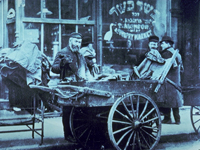
A gateway and an archive of numerous articles on New York history, this site "focuses a particularly long lens on the early history of political and economic events, panics, riots and other related matters affecting or contributing to New York City's development and growth." Its main feature is the New York state and New York City directories. (The U.S. directory is currently unavailable.) The New York state directory offers more than 700 links and more than 60 articles organized under 21 topics that include the arts, cities and counties, ethnic groups, military, societies and associations, transportation, women and their professions, and worship.
The New York City directory offers more than 5,200 links and more than 700 articles organized under 58 topics that include architecture, the arts, business matters, city government, clubs and societies, crime and punishment, education, ethnic groups, 5th Avenue, Harlem, immigration, New York City panics, real estate, temperance and prohibition, and Wall Street. The visitor can search the entire site or each directory by keyword. This site is a good starting point for researching the history of New York. It should also be useful for literary scholars, writers, and historical societies.
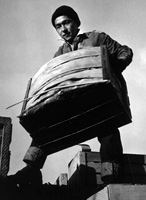
During World War II, the U.S. Government forced more than 100,000 Japanese Americans to leave their homes and businesses, relocating them to internment camps from California to Arkansas. Well-known photographer Ansel Adams documented the lives of Japanese Americans at the Manzanar War Relocation Center in California—from portraits to daily life, including agriculture and leisure.
This site presents 242 original negatives and 209 photographic prints, often displayed together to show Adams's developing and cropping techniques. His 1944 book on Manzanar, Born Free and Equal is also reproduced. Adams donated the collection to the Library of Congress in 1965, writing, "The purpose of my work was to show how these people, suffering under a great injustice . . . had overcome the sense of defeat and dispair [sic] by building for themselves a vital community in an arid (but magnificent) environment."
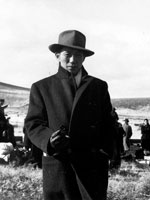
Based on a 1987 Smithsonian exhibition, this site allows visitors to click and drag through sections of text, music, personal accounts, and images that tell stories of the forced—and ultimately determined to be unconstitutional—internment during World War II of 120,000 Japanese Americans living on the West Coast. Also provides searching capabilities to retrieve images of more than 800 artifacts relating to the lives of those interned.
Sections in the narrative cover immigration, removal, internment, loyalty, service, and justice. Provides a 5,000-word audio file of interview excerpts; 6,400-word accompanying text from the 1994 traveling exhibition; annotated timeline; 72-title bibliography; 20 links to related sites; and two classroom activities. Also invites visitors to share their responses and to read those of others. Of value to students of Asian American history, the homefront during World War II, and constitutional issues.
How did segregation shape daily life for generations of African Americans and how do its legacies remain with us today?
Textbooks locate segregation’s origins in Southern disenfranchisement laws of the 1890s and highlight the Supreme Court's 1896 "separate but equal" ruling in Plessy v. Ferguson. New job opportunities during World War I and the Great Migration are briefly addressed along with "custom and tradition". Textbooks emphasize the National Association for the Advancement of Colored People's legal challenges, and portray the 1954 Brown v. Board decision as the culmination of the fight. Thus, according to the textbooks, from the 1890s to the 1950s, African Americans endured as best they could.
Primary sources provide ample evidence of segregation's brutality. They demonstrate the kind of structural inequalities that white supremacist laws and practices institutionalized but also that African Americans embraced a variety of methods to combat Jim Crow's injustices, and that white allies occasionally joined them. Collectively, the primary sources included here reveal how geography, class, gender, and culture have influenced ongoing battles for justice, as have changing national and international contexts.
Historians debate the origins of Jim Crow, but it is important to remember that slavery had mandated the use of laws and practices to govern interracial relations. Separation from whites by choice accompanied freed people's desire for independence from their former white owners even as they expected the full and equal citizenship guaranteed to them by the 14th Amendment.
Segregation contradicts what most students have learned about American freedom and democracy. Textbooks discuss de jure [in law] segregation as a great inconvenience that began in the 1890s and soon spread to every aspect of Southern daily life. Most routinely ignore:
Textbooks that portray segregation as a prelude to a more celebratory narrative of the civil rights era collapse the history of earlier generations of African Americans into a monolithic victimhood.
While the South's vicious de jure system stands apart, the rest of the nation's reliance on both informal custom and formal policy means that segregation—as well as the white supremacy and federal complicity that sustained it—cannot be dismissed as a regional aberration in an otherwise democratic nation.
Segregation contradicts what most students have learned about American freedom and democracy. Textbooks locate segregation's origins in southern disenfranchisement laws of the 1890s and highlight the Supreme Court's 1896 "separate but equal" ruling in Plessy v. Ferguson. The majority of African Americans still lived in the south and worked as agricultural laborers for white landowners who denied them an education and exploited them economically. New job opportunities during World War I offered one escape.
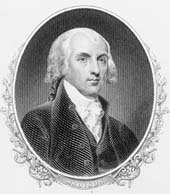
NOTE: Unpublished because ConSource website moved and does not appear to feature this link. Contacted ConSource about this and did not hear back.
In this classroom-tested lesson, students use primary sources and a close reading of the Preamble to the Constitution to better understand its meaning and significance.
In this lesson, students use primary sources related to the U.S. Constitution (specifically, Madison’s notes on the convention) to better understand the Preamble to the Constitution. This provides a great opportunity to teach an important element of historical thinking—the use of multiple sources to better understand the significance and meaning of one source. This is also an important part of contextualizing documents, or understanding how they relate to events and conditions at the time they were written.
The lesson guides students through the process of closely reading an important historical text. The steps in the lesson are clear and easy to follow, and breaking the Preamble down one clause at a time gives students a great opportunity to understand the purpose of one of the most important documents in the history of the United States, in addition to helping them learn how to read a text closely and carefully. Additionally, the "check for understanding" questions after each clause give teachers multiple opportunities for evaluating students' comprehension and modifying instruction. Depending on students' levels of understanding, teachers may want to supplement the provided questions with more probing questions of their own.
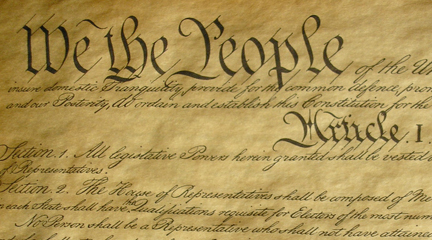
Yes
Yes
The lesson contains a link to one source that provides context, but elsewhere on the site there exists a wealth of documents providing context for the Preamble to the Constitution.
Yes
The lesson is centered on a close reading of the Preamble to the Constitution. In addition, teachers may use the "check for understanding" questions provided throughout the lesson as writing prompts.
Yes
Yes
Yes
Yes
While the explanations of each clause will facilitate understanding of the Preamble, teachers will want to develop ways to scaffold the other documents to make them more accessible to students.
Yes
While no assessment is included in the lesson, teachers could easily develop an assessment using the "check for understanding" questions.
Yes
Yes
In the library of an Oakland, CA, middle school, four 8th-grade American history teachers are gathered around a table. A doctoral student in U.S. History, the school librarian, and two staff members from the Oakland Unified Teaching American History (TAH) Grant's professional development project join them. The teachers have come from three different schools to observe a lesson on the Fourth Amendment they have planned together.
They wanted students to understand the ideas, rights, and controversy embedded in the dry language of the Constitution. The lesson began in a dramatic fashion. The teacher who was teaching the lesson arranged for a campus security guard to walk into the classroom and search the backpacks of three students. The students had agreed before class to participate in the simulation. After the search, students in the class were asked to write a brief response explaining whether they thought the search was legal. A discussion of this question followed. Then the students read and tried to rewrite the Fourth Amendment in their own words.
Reading and understanding the Amendment proved, as the teachers anticipated, a challenge to many of the students in this class, which included a number of second-language students. At one point the teacher asked, "What do you think they mean by the term effects?" As the teachers had predicted the students had difficulty in explaining how the term was used in this context.
After this introduction, the teacher passed out the Supreme Court case, T.L.O. v. New Jersey (1985), which asked what rights students have against search and seizure if they are on school grounds. (The court ruled they don't have the same rights as individuals outside the authority of the school.) Finally, students were asked to revise what they had written at the beginning of the period on whether or not the search was legal.
Initially, the group of teachers clustered around the table was certain that the lesson was successful; students seemed to understand that there were limitations to their Fourth Amendment right to not be searched. Then, the student writing samples were passed out to each teacher. After reading what students wrote the mood at the table changed, for it became clear that the students had gained, at best, only a limited understanding of the Fourth Amendment and how it is applied in a variety of situations and contexts. They did not see how the Fourth Amendment had been applied to the T.L.O. case and argued that school officials had no right to search their belongings without a warrant or probable cause.
As this finding emerged, teachers began to reconsider the design of their lesson—what would they do differently next time? When the lesson was taught again, it benefited from this close examination of instruction and student learning. Indeed, to help the students better understand how the Fourth Amendment had been applied, the teachers refined the lesson to provide a greater focus on the actual court ruling and reasoning in T.L.O., as well as looking closely at additional significant Fourth Amendment cases in American history.
This brief example of teacher collaboration illustrates one aspect of the Oakland TAH program. This collaborative process is known as lesson study.
The Oakland Unified School District has received two TAH grants. Each project had the goal of increasing teacher content knowledge of American history and connecting classroom teachers and professional historians. But, working to increase teacher content knowledge of American history was just a first step towards achieving the main goal of the project—increasing student knowledge, understanding, and achievement in American history. This goal raises the fundamental question we sought to answer in our projects:
"How can the enhanced historical knowledge gained by teachers find its way into their lessons and thus increase student knowledge and understanding of American history?"
From long experience in professional development, it is clear the most challenging aspect of this work is helping teachers make connections between what is learned in a workshop and what happens in their classrooms. Lesson Study helped us meet our goal of strengthening that connection.
As described above, "Lesson Study" provides an ongoing method to examine, refine, and improve instruction. The process is quite basic. A group of 35 teachers meet to plan a lesson on a specific historical topic and identify what important information, ideas, and concepts they want the students to understand. The lesson is then taught in one group member's classroom, while the other teachers and project staff observe. After the observation the group members and project staff meet to analyze, with a focus on student talk and writing and on how successful the lesson was in achieving the instructional goals they set for themselves. Based on this discussion, the teachers then refine and/or revise the lesson before it is taught in another group member's classroom.
It is important to note two very important details about what is accomplished in the planning phase:
1. The teachers develop a student question for the lesson. The student question guides the selection of materials and activities that will help students develop thoughtful and accurate responses. It also identifies what student words and work will be the focus of the teachers' analysis of the lesson's effectiveness.
2. The teachers also develop a research question for themselves about the teaching and learning of American history. This both focuses the lesson planning and the gathering of data, and gives the lesson importance beyond the immediacy of its topic and teaching.
Below are some examples of how past lesson study groups connected their student and teacher questions.
A fifth grade lesson focused on Chinese immigration through family photos:
Student question: What can we learn from this picture about the experiences of Chinese immigrants?
Teacher question: Can students use an immigration story to understand a larger historical movement? (A focus on making generalizations and inferential thinking.)
A fifth grade lesson focused on the experiences of slaves and questions of freedom. The class had read the historical novel A Picture of Freedom: The Diary of Clotee, a Slave Girl, by Patricia C. McKissack:
Student question: Which characters in the book have the most and least amount of freedom?
Teacher question: Can students develop a nuanced understanding, through multiple perspectives, of freedom at this time and place in American history?
An eighth grade lesson on Nat Turner:
Student question: Was Nat Turner's Revolt a success?
Teacher question: How can we help students understand that it is possible to tell different stories and come to different conclusions about the same event?
An 11th grade lesson on Populism:
Student question: How successful was the Populist Party?
Teacher Question: How can we teach students to use evidence to support their argument?
We found that Lesson Study, both through its promise and its implementation addressed a genuine need among history teachers for a systematic way of learning about how to improve instruction, but it was not without its challenges. Lesson study takes time, a scarce resource for teachers. It requires meeting after school and finding and locating resources for a lesson. It requires an understanding among members that by investigating a lesson they might come to different answers and understandings about how best to increase student knowledge and understanding. Indeed, a number of lesson study groups were not able to overcome these challenges. Some teachers showed up late to meetings, or didn't show up at all. Some teachers planned extensively while others in the group did not contribute an equal share. Also, lesson study requires a stance towards teaching and collaboration that is often at odds with how teachers work together at school sites. A successful lesson study develops a lesson that is seen by group members as "our" lesson, rather than the lesson of the teacher who is going to teach it first.
So why would teachers want to continue with lesson study? The answer can be found in what teachers believed to be beneficial besides the opportunity to collaborate. Not only did lesson study address a need, but it helped meet the need. Over three quarters reported that they actually learned something new about their teaching—something that was revealed to them through the lesson study process. There was the learning of new content as lessons were developed and materials selected. Indeed, a number of groups chose to focus their lessons on topics they had not taught in depth before, such as Nat Turner and slave rebellions, McCarthyism and the Cold War, or the Fourth Amendment in American history.
There were also new specific instructional strategies designed to help students learn and understand more about American history. For example, groups focused on how to help students read difficult primary source documents, move from specific historical details to generalizations about a time or place, or see a specific event through the multiple perspectives of the time. And there was new learning around the big instructional questions teachers framed for themselves. "Can fifth grade students develop a nuanced understanding of freedom and slavery?" "How to help students use historical evidence to develop and support an historical argument?"
To support lesson study through TAH activities, our efforts have focused on linking lesson studies with historians' presentations. This allows us to provide resources (documents, activities, readings, etc.) that support teachers through the lesson planning phase so they can focus on the lesson analysis portion. The analysis portion, framed by a teacher research question, is often the part of teaching that teachers are unable to make time for as they try and meet the demands of moving through their American history curriculum.
When we first started with lesson study we didn't stress this aspect enough, even though we understood the research nature of the process. We learned that having a teacher question helped immensely in focusing on student understanding as a means for evaluating the lesson's success and instructional meaning. For lesson study to be truly successful, it should help teachers improve the instruction of a particular lesson, inform their instruction beyond that one lesson, and influence future instructional decisions and choices. Why else spend that much time on one lesson?
Lewis, Catherine, "Lesson Study: A Handbook for Teacher-Led Instructional Change," (Research for Better Schools, 2002).
Stigler, James and Hiebert, James, "The Teaching Gap: Best Ideas from the World's Teachers for Improving Education in the Classroom," (New York: Free Press, 1999).

These published works, manuscripts, images, and motion picture footage address the formation of the movement to conserve and protect America's natural heritage. Materials include 62 books and pamphlets, 140 Federal statutes and Congressional resolutions, 34 additional legislative documents, and excerpts from the Congressional Globe and the Congressional Record. An additional 360 presidential proclamations, 170 prints and photographs, two historic manuscripts, and two motion pictures are available.
Materials include Alfred Bierstadt paintings, period travel literature, a photographic record of Yosemite, and Congressional acts regarding conservation and the establishment of national parks. An annotated chronology discusses events in the development of the conservation movement with links to pertinent documents and images.